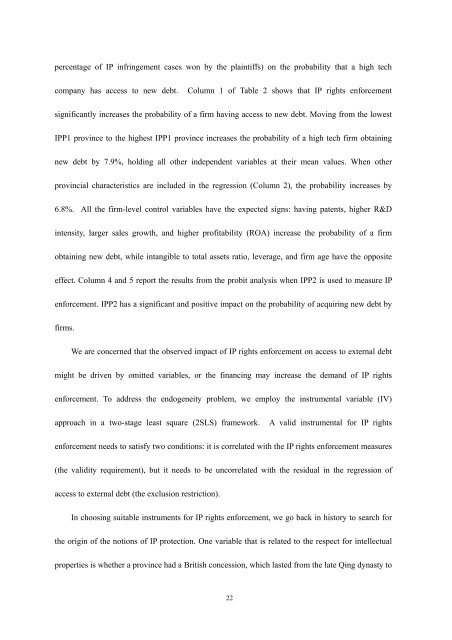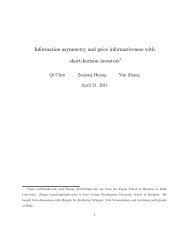Does Enforcement of Intellectual Property Rights Matter in China ...
Does Enforcement of Intellectual Property Rights Matter in China ...
Does Enforcement of Intellectual Property Rights Matter in China ...
You also want an ePaper? Increase the reach of your titles
YUMPU automatically turns print PDFs into web optimized ePapers that Google loves.
percentage <strong>of</strong> IP <strong>in</strong>fr<strong>in</strong>gement cases won by the pla<strong>in</strong>tiffs) on the probability that a high tech<br />
company has access to new debt. Column 1 <strong>of</strong> Table 2 shows that IP rights enforcement<br />
significantly <strong>in</strong>creases the probability <strong>of</strong> a firm hav<strong>in</strong>g access to new debt. Mov<strong>in</strong>g from the lowest<br />
IPP1 prov<strong>in</strong>ce to the highest IPP1 prov<strong>in</strong>ce <strong>in</strong>creases the probability <strong>of</strong> a high tech firm obta<strong>in</strong><strong>in</strong>g<br />
new debt by 7.9%, hold<strong>in</strong>g all other <strong>in</strong>dependent variables at their mean values. When other<br />
prov<strong>in</strong>cial characteristics are <strong>in</strong>cluded <strong>in</strong> the regression (Column 2), the probability <strong>in</strong>creases by<br />
6.8%. All the firm-level control variables have the expected signs: hav<strong>in</strong>g patents, higher R&D<br />
<strong>in</strong>tensity, larger sales growth, and higher pr<strong>of</strong>itability (ROA) <strong>in</strong>crease the probability <strong>of</strong> a firm<br />
obta<strong>in</strong><strong>in</strong>g new debt, while <strong>in</strong>tangible to total assets ratio, leverage, and firm age have the opposite<br />
effect. Column 4 and 5 report the results from the probit analysis when IPP2 is used to measure IP<br />
enforcement. IPP2 has a significant and positive impact on the probability <strong>of</strong> acquir<strong>in</strong>g new debt by<br />
firms.<br />
We are concerned that the observed impact <strong>of</strong> IP rights enforcement on access to external debt<br />
might be driven by omitted variables, or the f<strong>in</strong>anc<strong>in</strong>g may <strong>in</strong>crease the demand <strong>of</strong> IP rights<br />
enforcement. To address the endogeneity problem, we employ the <strong>in</strong>strumental variable (IV)<br />
approach <strong>in</strong> a two-stage least square (2SLS) framework. A valid <strong>in</strong>strumental for IP rights<br />
enforcement needs to satisfy two conditions: it is correlated with the IP rights enforcement measures<br />
(the validity requirement), but it needs to be uncorrelated with the residual <strong>in</strong> the regression <strong>of</strong><br />
access to external debt (the exclusion restriction).<br />
In choos<strong>in</strong>g suitable <strong>in</strong>struments for IP rights enforcement, we go back <strong>in</strong> history to search for<br />
the orig<strong>in</strong> <strong>of</strong> the notions <strong>of</strong> IP protection. One variable that is related to the respect for <strong>in</strong>tellectual<br />
properties is whether a prov<strong>in</strong>ce had a British concession, which lasted from the late Q<strong>in</strong>g dynasty to<br />
22



